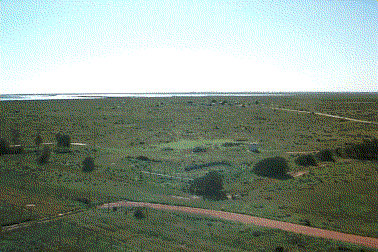
| The University of Adelaide: School of Chemistry and Physics |
|
|
 |
You
are here: |
|
|
Buckland Park Facilities
MF array as seen from above the VHF hut. In the background local salination pans can be seen. At its main field site at Buckland Park the group has a range of equipment at their disposal. Often the equipment is undergoing upgrades or major modifications but at this stage all of them are functioning. MF Radar. A unique radar which can operate in Doppler mode as well as the usual Spaced Antenna. This gives us a rare and very valuable tool for probing the upper atmosphere. Heights of interest are from 60km to above 100km. VHF Radar. Recently upgrade to enable steering of the beam upon transmission in the north-south direction this complements the East-West abilities with were already present. The doppler capabilities coupled with the spaced antenna facilities via three yagi groups result in a powerful radar for experimentation and research, able to probe from 2km to 15km. VHF BL Radar. (Very High Frequency Boundary Layer Radar). A relatively recent addition to BP this prototype radar offers an alternative aswell as advantages to the present UHF BL radars used elsewhere in the world. Extremely promising results are been obtained giving a radar which is able to obtain measurments from 300m to beyond 5km. RASS. (Radio Acoustic Sounding System). This is still in its development stage but temperature measurements have been obtained to height of around 1.5km when combined with the BL Radar. Further Acoustic source will enable greater height range when coupled with the BL and the VHF radars. Lidar (LIght Detection And Ranging). Within the School of Chemistry and Physics the Atmospheric Physics Group in collaboration with Optics and Photonics Group are setting up a new Lidar facility at Buckland Park. The aim of this project is to measure atmospheric temperature, wind and dynamical processes with high spatial and temporal resolution from 10 to 105 km altitude. Together with the co-located radar and passive optical systems it will deliver a unique set of data from the troposphere up to the lower thermosphere. 3-field photometer observes atmospheric airglow each night whenever the moon is not up. It observes the intensity of the OH (6-2) emission at 730nm and the O line at 557.7nm; results can be used to infer gravity wave parameters through a night and variations over longer timescales.
|